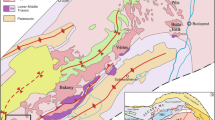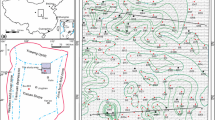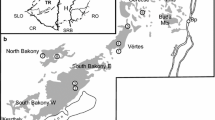Abstract
Abu Shaar is a mixed siliciclastic/carbonate fault- bounded platform. Aragonite bioclasts have dissolved, but calcitic bioclasts and the sediment matrix are mimetically replaced by dolomite. Four types of water have been suggested to be involved in the dolomitiza- tion: meteoric, normal marine, hypersaline and hydro- thermal. Well-preserved unstable calcic feldspars within dolomites suggest that waters undersaturated with respect to these feldspars, including surface meteoric waters, were never present in sufficient quantities to result in mixing-zone dolomitization, nor have such waters been responsible for precipitating pre- or syn- dolomitization meteoric cements. Stable isotopic values of the dolomites extend over a range of δ18O 2 per mil to −10 per mil VPDB and δ13C 3 per mil to −11 per mil. Since meteoric waters are unlikely to be involved, it is probable that the negative oxygen isotope values represent the influence of higher temperatures on isotope fractionation, probably due to heated waters exploiting basement fractures. Light carbon isotopes can be attributed to the influence of hydrocarbons. The small number of positive oxygen isotope values indicates that a surface normal marine or hypersaline sea water has also been involved. Mixing of these two waters in the platform deposits has resulted in almost complete dolomitization of the carbonates.
Post-dolomitization hydrothermal cements are present along the footwall margin. They are largely calcitic, often preceded by iron oxides, and contain thin bands of dolomite. Distribution of the cements suggests that they were precipitated from a fluid sourced from the footwall fault. Stable isotopes suggest that this fluid was heated, contained abundant organic carbon and had mixed with surface sea water. A second type of calcite cement, preceded by an evaporite residue, shows vadose textures throughout the slope. These vadose cements and cements from the centre of the platform have similar oxygen and carbon stable isotope values to the hydrothermal cements, and may therefore have a similar origin.
Access this chapter
Tax calculation will be finalised at checkout
Purchases are for personal use only
Preview
Unable to display preview. Download preview PDF.
Similar content being viewed by others
Editor information
Editors and Affiliations
Rights and permissions
Copyright information
© 1998 Springer Science+Business Media Dordrecht
About this chapter
Cite this chapter
Clegg, N., Harwood, G., Kendall, A. (1998). The dolomitization and post-dolomite diagenesis of Miocene platform carbonates: Abu Shaar, Gulf of Suez, Egypt. In: Purser, B.H., Bosence, D.W.J. (eds) Sedimentation and Tectonics in Rift Basins Red Sea:- Gulf of Aden. Springer, Dordrecht. https://doi.org/10.1007/978-94-011-4930-3_21
Download citation
DOI: https://doi.org/10.1007/978-94-011-4930-3_21
Publisher Name: Springer, Dordrecht
Print ISBN: 978-94-010-6068-4
Online ISBN: 978-94-011-4930-3
eBook Packages: Springer Book Archive




